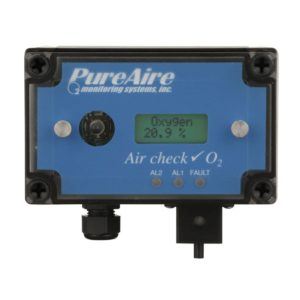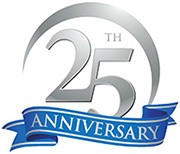Industrial Uses for Oxygen Depletion Monitors
- By : PureAire Monitoring Systems
- Posted on : April 03, 2024
- News Room
Introduction
Oxygen (O2) deficiency monitors, also known as oxygen depletion monitors, are vital safety equipment used across a wide array of industries that help ensure personnel safety. These safety monitoring systems detect low levels of oxygen in the air and will trigger visual and audible alarms when oxygen concentrations drop to an unsafe level. Unsafe, oxygen-deficient environments are defined by the Occupational Safety and Health (OSHA) as oxygen concentrations at or below 19.5%.
Industries that utilize cryogenic gases such as nitrogen, helium, argon, and carbon dioxide need to evaluate areas where these oxygen-depleting gases are stored or used due to the potential for a gas leak. In such cases, oxygen safety monitoring systems are essential to alerting occupants of oxygen-deficient conditions.
To understand more about Oxygen Monitoring System Requirements, including the need for fixed air monitoring systems in specific scenarios, you can refer to this resource by the National Institutes of Health (NIH). It states that an oxygen monitoring device shall be installed in any indoor location where compressed gases or cryogenic liquids are stored and/or dispensed in a manner that could potentially cause the displacement of oxygen. Furthermore, it’s crucial to be aware of OSHA’s regulations on oxygen exposure limits and their approach to assessing hazards.
Understanding O2 deficiency
O2 deficiency may be created when oxygen is displaced by inert gases, such as nitrogen, helium, argon, or carbon dioxide. An oxygen-deficient environment is often the result of inert gases displacing oxygen through gas leaks. These scenarios are particularly hazardous in industrial settings, where they can lead to critical health risks for personnel. Recognizing the symptoms of O2 deficiency is vital. Exposure to an oxygen-deficient environment includes the following symptoms at the O2 concentrations listed in the table below.
Oxygen (% vol) |
Health Effects |
| 20.9 – 19 % – | Little to no effect in healthy adults |
| 15 – 19 % – | Increased breathing rate, accelerated heartbeat. Impaired attention, thinking & coordination without awareness. |
| 12 – 15 % – | Poor judgment. Faulty coordination. Abnormal fatigue upon exertion. Emotional upset. |
| 10 – 12 % – | Very poor judgment & coordination. Impaired respiration that may cause permanent heart damage. Possibility of fainting within a few minutes without warning. Nausea & vomiting. |
| < 10 % – | Nausea, vomiting, lethargic movements, or the inability to move. Fainting almost immediately. Loss of consciousness. Convulsions. Death |
O2 deficiency monitors contribute to safe working environments in any scientific or industrial application utilizing oxygen-depleting gases and, therefore, requiring continuous monitoring of oxygen levels.
Industries, including manufacturing, laboratories, and operations involving confined spaces, must be vigilant about monitoring oxygen levels. Workers in these environments are at an increased risk and require protection against the silent threat posed by oxygen-depleted air. For more detailed guidelines on maintaining safety with oxygen monitoring devices, please refer to OSHA’s standards: Minimum Oxygen Concentration – 29 CFR 1920.146, Hazardous Atmosphere Prevention – 1910.146, Appendix B, and Monitoring Requirements – 1910.146(d)(5)(ii). Additionally, always check with your state and local authorities.
The presence of reliable oxygen depletion monitors becomes indispensable to alert staff promptly when oxygen levels fall below safe thresholds, allowing for immediate corrective measures to safeguard human health and productivity.
Importance of O2 Deficiency Monitors in Different Industries
- Medical Industry-O2 deficiency monitors play a crucial role in ensuring the safety of medical professionals and patients during MRI procedures. These monitors are essential for detecting and alerting staff to any potential O2 deficiency, thereby preventing any adverse health effects due to low oxygen levels. In cryosurgery, where extremely low temperatures destroy abnormal tissues, O2 monitors are vital for safeguarding the well-being of patients and medical personnel in the operating room. IVF laboratories and cryostorage facilities also rely on O2 deficiency monitors to maintain optimal conditions for the preservation of embryos and reproductive cells.
- Pharmaceutical Manufacturing-Pharmaceutical manufacturing is an industry that requires strict control over the production and storage environments to ensure the quality and safety of drugs. O2 deficiency monitors play a crucial role in maintaining controlled environments in this industry.
- Maintaining Controlled Environments-O2 deficiency monitors are used to monitor and control oxygen levels in various areas of pharmaceutical manufacturing facilities. This is particularly important in cleanrooms, where drugs are manufactured under highly controlled conditions to prevent contamination. By continuously monitoring oxygen levels, these monitors ensure that the environment remains within the specified range for drug production.
- Preventing Oxidation-Many drugs are sensitive to oxidation, which can degrade their effectiveness or even render them useless. O2 deficiency monitors help maintain low oxygen levels by alerting personnel to changes in O2 levels, thereby reducing the risk of oxidation and preserving the quality of pharmaceutical products during manufacturing and storage.
- Ensuring Worker Safety-Pharmaceutical manufacturing facilities often utilize hazardous chemicals and gases. O2 deficiency monitors provide an added layer of safety by alerting workers to potential oxygen depletion, which can occur due to leaks or improper ventilation. By detecting low oxygen levels early on, these monitors help prevent hazardous situations.
- Compliance with Regulatory Standards-The use of O2 deficiency monitors in pharmaceutical manufacturing is essential for complying with regulatory standards set by organizations like the FDA. These standards aim to ensure that drugs are produced in safe environments and meet the required quality standards. Oxygen depletion monitors help companies meet these standards by providing continuous monitoring and ensuring worker safety.
- Laboratories and Research Facilities-Research laboratories and facilities extensively rely on various gases during experimentation and testing procedures. Oxygen depletion monitors are an integral safety measure, alerting personnel to a dangerous drop in oxygen levels caused by gas leaks or improper handling of gas cylinders. A low-oxygen alert serves to prevent health risks such as hypoxia, contributing to a safe working environment. Laboratories handling materials like liquid nitrogen, helium, or argon find these monitors particularly beneficial as these gases can quickly displace oxygen, posing a serious risk to workers.
- Food and Beverage-O2 deficiency monitors are important to maintaining safe and controlled environments throughout the food and beverage industry. Oxygen depletion monitors help prevent contamination and ensure the quality control of perishable goods during production. By continuously monitoring oxygen levels, the monitors detect excessive levels of oxygen, which can lead to potential hazards that can affect the integrity of food and beverage products. This is especially crucial in environments requiring specific gas compositions to preserve product freshness and safety.
- Semiconductor Fabrication and Foundries-O2 deficiency monitors help to ensure the precise gas compositions required for various manufacturing processes. These monitors help maintain optimal oxygen levels to prevent any contamination during the production of semiconductor materials. Semiconductor fabrication facilities rely on these monitors to regulate process gas levels and ensure the safety and efficiency of their operations.
- Aerospace Applications-The aerospace industry utilizes oxygen depletion monitors to protect workers from potential hazards in aircraft assembly and maintenance operations. Oxygen depletion monitors are crucial to protecting personnel working in confined spaces and areas with low oxygen levels. During aircraft construction, assembly, and maintenance, aerospace personnel may work with various oxygen-depleting gases in confined spaces. Oxygen depletion monitors can be used in confined spaces and can detect any decrease in oxygen levels, alerting personnel to evacuate the area and take corrective action.
- Alternative Fuel Production and Waste Management – Oxygen depletion monitors, including the oil and gas industry, are essential in alternative fuel production and waste management. They help ensure safety during the production of renewable fuels and the handling of waste materials. Biofuels and hydrogen production processes can involve the use of flammable gases and hazardous chemicals. Waste management facilities deal with various types of waste materials, including those that release toxic gases and deplete oxygen. Proper monitoring with oxygen depletion monitors is essential to protect workers from dangerous safety hazards.
PureAire Oxygen Depletion Monitors
PureAire Monitoring Systems’ Line of Oxygen Depletion Monitors is designed to safeguard against O2 deficiency safety risks across a number of industrial environments. The Monitors are built with long-life, non-depleting, zirconium oxide advanced sensor cell technology to accurately detect low oxygen levels and provide timely warnings to prevent potential hazards.
PureAire’s sensor cells offer long-term reliability and stability, ensuring continuous and accurate monitoring without the need for frequent sensor replacements. This innovative technology enhances operational efficiency and reduces maintenance costs, making PureAire’s monitors a trusted solution for industrial safety needs. A screen displays current oxygen levels for at-a-glance reading by employees, who derive peace of mind from the Monitor’s presence and reliable performance. In the event of a gas leak, and a decrease in oxygen to an unsafe level, PureAire’s Monitor will set off an alarm, complete with horns and flashing lights, alerting personnel to evacuate the area.PureAire’s Monitor will remain accurate at extremely low temperatures. PureAire’s Oxygen Monitors can last, trouble-free, for over 10 years under normal operating conditions.




